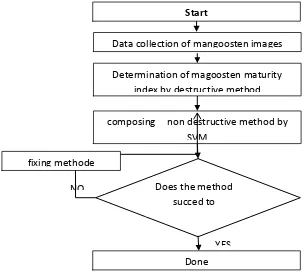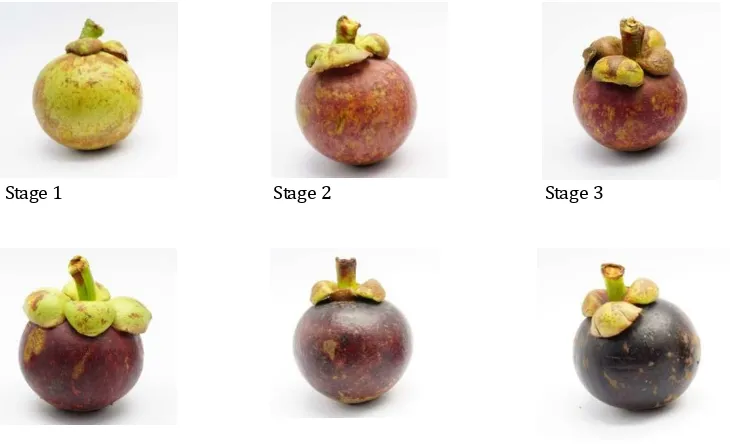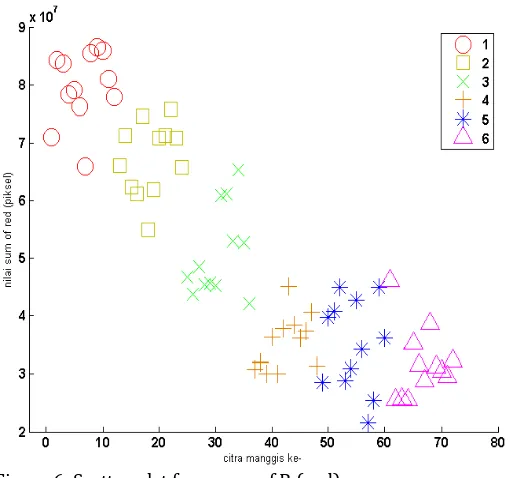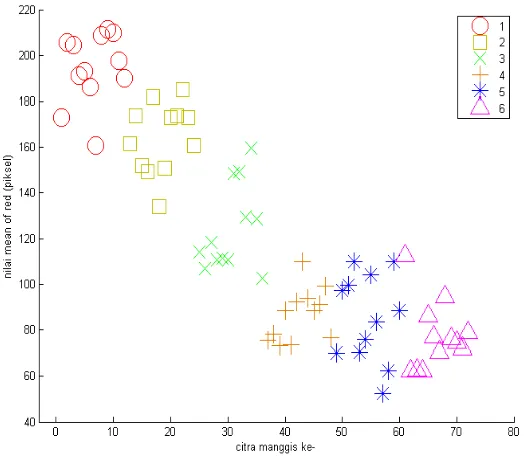Non destructive method for maturity index
determination of
Garcinia mangostana
L using image
processing technology
Indira Prabasari1, Nafi Ananda Utama1, Nur Azizah U. Hasanah1, Slamet Riyadi2, Tony K. Hariadi2
1Faculty of Agriculture, Universitas Muhammadiyah Yogyakarta, Indonesia 2Faculty of Engineering, Universitas Muhammadiyah Yogyakarta, Indonesia
Abstract
Postharvest maturity index for mangosteen (Garcinia mangostana L) is very important for picking and grading during postharvest processing. Skin color change is the primary maturity index for mangosteen. However determination using human eyes needed many skilled labours and was inconsistent therefore new method in image processing technology using SVM (Support Vector Machine) was employed in this study. Chemical analysis of mangosteen was performed and used as a reference of SVM method. The chemical analysis of mangosteen showed that anthocyanin content increased from 126.20 ppm at stage 1 to 213.98 ppm at stage 6. Reducing sugar content increased from 3.17% at stage 1 to 7.92% at stage 6. The same pattern was found for total soluble solid, an increase from 3.86% at stage 1 to 7.81% at stage 6. Whereas for total acid content and hardness the pattern was the opposite. Total acid content was decreased from 1.78% at stage 1 to 1.06% at stage 6 and the fruit hardness of mangosteen was also declined, showing the number from 4.30 N at stage 1 to 0.69 N at stage 6. For SVM method, image aquisition was conducted for mangosteen images from stage 1 to stage 6, followed by color feature extraction for each stages. The result was trained and tested using SVM and resulted accuracy level of 83.3%.
Introduction
Mangosteen (Garcinia mangostana L.) is a climacteric fruit with white flesh, juicy and sweet taste. The skin of mangosteen fruit (pericarp) is dark purple and rich with secondary metabolites of active compounds including anthocyanins, oligomers proanthocyanins and xantone (Fu et al., 2007; Jie, et al., 2007). Mangosteen is very popular in Indonesia and it is one of major horticultural export products. The export of mangosteen significantly increased however there is only approx. 11,79% are eligible to be exported due to the low quality of the fruit. The high post-harvest loss is caused by the difficulty of mangosteen maturity detection that results in declining quality of fruit (Palapol, et al., 2009).
Mangosteen is usually picked when the colour is pink to red across the skin. If it is picked too early the fruit will not be ripe perfectly and it degrades the quality (Tongdee and Suwanagul, 1989; Paull and Ketsa, 2004; Palapol, et al., 2009). The low quality of mangosteen makes the fruit is declined for export purposes and that is a loss for the farmer since the price of mangosteen overseas is about 5-8 higher than the local marketplace (Suyanti and Setyadjit, 2007).
of complex analysis that take a long time to finish. Therefore it is important to develop a non destructive method in determining the ripeness of the fruit. Mechanical analysis of non destructive ends for ripeness by color using a “neural network” (NN) and fuzzy already widely tested (Riyadi, et.al., 2007a; Riyadi, et.al., 2007b). Recently a new technique has been developed that is “support vector machine” (SVM) which has a higher degree of accuracy. Testing SVM on mangoes showed very good results with a 95% accuracy rate (Nandi et al., 2014).
Material and methods Mangosteen
Mangosteen was obtained from a fruit plantation in Purworejo, Central Java, Indonesia. The fruit was immediately brought to the Post Harvest Laboratory, Faculty of Agriculture Universitas Muhammadiyah Yogyakarta, Indonesia (UMY) and stored at room temperature. Mangosteen was classified based on the maturity level visually and divided into six criteria of maturity (Standard ASEAN STAN 10; 2008):
Stage 0: yellowish white or yellowish white with 5-50% scattered pink spots Stage 1: light greenish yellow with 5-50% scattered pink spots
Stage 2: light greenish yellow with 51-100% scattered pink spots Stage 3: spots not as distinct as in stage 2
Stage 4: red to reddish purple Stage 5: dark purple
Stage 6: purple black
Method of Destructive Fruit Maturity
Detection of maturity with destructive methods was performed to obtain the reference data of mangosteen maturity.
Extraction of anthocyanin - Methods of extraction and isolation of anthocyanins were modified from Lestario et al. (2011). Mangosteen peel was cut into small pieces then macerated with methanol containing 1% HCl in 1: 4 (w/v) overnight at 5oC. The filtrate was
filtered with Whatman no. 1, and partitioned with a separating funnel with the addition of diethyl ether to separate the components of non-anthocyanin (Ozela, et al., 2007). To add polarity in order to separate solvent well, it was added distilled water (filtrate volume ratio: diethyl ether: distilled water = 1: 2: 1).
Total Content of Anthocyanin - Method from Giusti and Wrolstad (1996) was used to determine the total anthocyanin content in the skin of mangosteen. Anthocyanin extract was dissolved in KCl-HCl buffer (1M, pH 1) and NaOAc buffer (1M, pH 4.5) with a ratio of extract against buffer was 1: 5 (v/v). Each solution was measured its absorbance at 520 nm and 700 nm after incubation for 15 min at RT and the results was incorporated into the formula A = [(A510-A700)pH1 - (A510-A700)pH4,5] and calculation was incorporated into the law of
Lambert-Beer that A = ε.L.C.
Analysis of Reducing Sugar - Reducing sugar analysis was done used Nelson-Somogyi method. Mangosteen flesh was destroyed and filtered. Sample of 1 mL was added with distilled water up to 10 mL and taken 1 mL to be added with 9 mL of distilled water. Diluted samples was taken 1 mL and mixed with Nelson mixture (Nelson mixture of A and B 25: 1 (v /v)) then heated at 100°C for 20 min. The sample was cooled at RT. Sample was added with 1 mL of arsenomolybdat and 7 mL of distilled water and then shaken. The sample was measured its absorption at 510 nm.
Analysis Tertitrasi acid (TA) - It was conducted by making a filtrate flesh of mangosteen (5 mL) and titrated with 0.1 M NaOH.
Fruit Hardness Test - Fruit hardness test was done with a hand held penetrometer.
Non destructive methods in detection of fruit maturity by image processing technology The development of non destructive methods to mangosteen in this study was conducted in three main phases: 1) data collection, 2) determining the maturity index of the mangosteen with a destructive method, 3) the manufacturing method of non-destructive method SVM and 4) validation of the results, such as shown in Fig. 1.
Figure 1: Development of non-destructive method for mangosteen maturity index
The description of each phases of the development of non dektruktif methods for mangosteen maturity as follows:
1. Data collection of Mangosteen - At this stage, mangosteen was photographed to obtain image data of mangosteen maturity from stage 1 to stage 6. The fruit was photograph using digital camera with 24 mp CMOS sensor in a light box of 60x40x50 cm to create even lighting.
2. Establishing image processing technology method- The process of SVM method began with the extraction of RGB (red, green blue) color features of mangosteen image. RGB features were summed and averaged for each colour and 6 values were processed in the SVM method.
3. Results validation - Validation of the results was done to determine whether the determination of maturity index with SVM method gave accurate results as the destructive method. The data reference was the concentration of anthocyanin content and supporting data including sugar, TSS, TA and fruit hardness test.
Determination of magoosten maturity
index by destructive method
Result and discussion
Destructive method in fruit maturity detection
Ripening process of mangosteen from stage 1 to 6 showed an increase in anthocyanin content from 126.20 ppm at stage 1 to 213.98 ppm at stage 6 (Fig. 2). The increase of anthocyanin was reflected in the change of its skin color from stage 1 to stage 6 as shown in Fig. 3. The skin color changes correlated with ethylene production and it was shown by our data on other chemical compound changes we will be discussed later. Studies showed that the development of skin color in outer pericarp of mangosteen was correlated with the increase of cyanidin-3-sophoroside and the cyanidin-3-glucosides during ripening process (Palopol et.al., 2009). Reducing sugar increased from 3.17% at stage 1 to 7.92% at stage 6 during ripening process as shown in Fig. 4, and this indicated glycolysis process where polysaccharides converted into glucose. This finding was supported by the increase of total soluble solids from from 3.86% at stage 1 to 7.81% at stage 6 and the decrease of total acid content from 1.78% at stage 1 to 1.06% at stage 6 as shown in Fig. 4. These phenomenon was affected by the increase in ethylene production during ripening process of mangosteen as suggested by Palopol et.al. (2009). Fig. 5 showed the decrease of hardness from 4.30 N at stage 1 to 0.69 N at stage 6 indicated degradation of pectin in the cell wall, and this also found in other fruit like oranges (Prabasari et.al., 2011).
Figure 2. The increase of anthocyanin content during ripening of mangosteen
Stage 4 Stage 5 Stage 6
Figure 3. Maturity stages of mangosteen during ripening. The skin color changed from yellow green in stage 1 to deep purple in stage 6
Figure 4. The increase of reducing sugar, total soluble solid and total acid during ripening of mangosteen
Figure 5. The decrease of hardness during ripening of mangosteen
Non destructive methods in fruit maturity detection
Figure 6. Scatter plot from sum of R (red)
Figure 8. Scatter plot from sum of B (blue)
Values of mean from R, G and B were put into scatter plot and the result was shown in Fig. 9, 10 and 11. The pattern resulted were similar with the pattern from sum of R, G and B. Obvious grouping can be detected clearly between stages although slightly overlapped grouping was found in stage 4, 5 and 6. The scatter plot from the sum and mean of R, G and B when counted together indicated characteristics of grouping of R, G and B and showed that it was possible to be used as a non destructive methods to diffrentiate stages of mangosteen.
Figure 10. Scatter plot from mean of G (green)
Figure 11. Scatter plot from mean of B (blue)
Two characteristics resulted from sum and mean of R, G and B were used as input for training and testing of SVM as shown in Table 1. In stage 1 and 2, the accuracy were 100% whereas in other stages were between 50 and 85%. In summary, the mean of accuracy in detecting mangosteen maturity was 83.3%.
Stage Sum of image
Mean of accuraccy in stage detection 83.3
Conclusion
In conclusion, destructive methods showed characteristics of chemical compound changes during senescence and when the same samples were used to examine non destructive methods using image processing technology it showed the accuracy in detecting mangosteen maturity with the level 0f 83.3%.
References
Fu, C., Loo, A.E., Chia, F.P., Huang, D. (2007). Oligomeric proanthocyanidins from mangosteen pericarps. J. Agric. Food Chem. 55 : 7689–7694.
Giusti, M.M. dan Wrolstad, R.E. (1996). Characterization of red radish anthocyanins. J. Food. Sci.61 : 322-326.
Ji, X., Avula, B., Khan, I.A. (2007). Quantitative and qualitative determination of six xanthones in Garcinia mangostana L. by LC–PDA and LC–ESI-MS. J. Pharm. Biomed. Anal. 43 : 1270–1276.
Lestario, L.N., Rahayuni, E., Timotius K.H. (2011). Kandungan antosianin dan identifikasi antosianidin dari kulit buah Jenitri (Elaeocarpus angustifolius Blume). AGRITECH 31 (2) :93-101.
Nandi, C.S., Tudu, B., and Koley, C. (2014). Computer vision based Mango fruit grading system. International Conference on Innovative Engineering Technologies (ICIET 2014) Dec. 28-29, Bangkok Thailand. Palapol, Y., Ketsa, S., Stevenson, D., Cooney, J.M., Allan, A.C., Ferguson, I.B., (2009). Colour development and
quality of mangosteen (Garcia mangostana L.) fruit during ripening and after harvest. Postharvest Biol and Tech51: 349–353.
Paull, R.E., Ketsa, S. (2004). Mangosteen. In: Gross, K.C., Wang, C.Y., Saltveit, M.E. (Eds.), The Commercial storage of fruits vegetables and florist and nursery stocks.
Prabasari, I., Pettolina, F.P., Liao, M.L., Bacic, T. 2011. Pectic polysaccharides from mature orange (Citrus sinensis) fruit albedo cell walls: Sequential exreaxtion and chemical characterization. Carbohydrate Polymers (84), 484-494.
Riyadi, S., Husain, H., Mustafa, M.M., and Hussain A. 2007a. Papaya fruit grading based on size using image analysis. Proceeding of the International Conference on Electrical Engineering and Informatics 2007. pp 645-648.
Riyadi, S., Rani, A.A.A., Mustafa, M.M., and Hussain, A. 2007b. Shape characteristic analysis for papaya size classification. Proceeding of the 5th Student Conference on Research and Development 2007. pp 347-351.
penyimpanan. Buletin Teknologi Pascapanen Pertanian Vol. 3 : 66-73.
Tongdee, S.C., Suwanagul, A. (1989). Postharvest mechanical damage in mangosteen. ASEAN Food J. 4 : 151–155.





